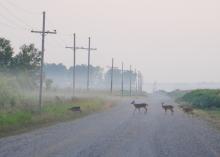Information Possibly Outdated
The information presented on this page was originally released on November 16, 2018. It may not be outdated, but please search our site for more current information. If you plan to quote or reference this information in a publication, please check with the Extension specialist or author before proceeding.
CWD management calls for ‘all hands on deck’
Hunters play a large role in helping to manage Mississippi’s deer population. Hunters not only help control deer numbers but also provide statewide harvest data that gives biologists insight into deer numbers, health and conditioning.
As we enter the first deer hunting season since the confirmation of chronic wasting disease -- or CWD -- in the state, we need assistance from Mississippi deer hunters more than ever.
As of mid-November, there have been three confirmed cases of CWD in Mississippi deer: two in Issaquena County and one in Pontotoc County. Given the distance between these two counties -- roughly 170 air miles -- the Issaquena and Pontotoc cases are likely from two different sources.
The great unknown is how widespread the disease is among the deer populations in each of these areas and throughout the state. That’s where hunters can be of great assistance and play an important role in helping deer biologists and researchers monitor and manage this disease.
The Mississippi Department of Wildlife, Fisheries and Parks is asking deer hunters to submit the heads of their harvested deer for CWD testing. Samples will be collected and tested from road-kill deer, as well as from deer harvested on wildlife management areas and refuges. However, we also need as many samples as possible from private land throughout the state.
No fee is required, and participation is not mandatory, but hunter cooperation is greatly needed and encouraged. The more samples submitted for CWD testing, the better biologists and researchers will be able to assess where the disease is distributed throughout the state. In addition, concerned hunters will get the opportunity to have their harvested deer tested before they consume the meat.
Wildlife officials also ask that citizens be on the lookout and report any deer that appear to be diseased. Clinical symptoms of CWD include extreme weight loss, excessive salivation, and/or erratic behavior. To report a deer exhibiting these symptoms, call 1-800-BE-SMART.
Currently, wildlife officials have designated 21 locations around the state as drop-off points for CWD testing. CWD sampling requires testing the lymph nodes adjacent to the deer’s throat. Harvested deer should remain cool until testing to reduce tissue decomposition and provide accurate results. Heads submitted for testing should be removed from the carcass with at least 6 inches of neck attached. Officials prefer antlers be removed before heads are submitted for testing. The goal for completing each test is about two weeks.
It’s anyone’s guess how far CWD may have already spread or where it may surface next in the state. It’s still early in the game for Mississippi, but CWD is here, and now we must manage it. Management begins with getting a better picture of where the disease is distributed.
Traveling to and from drop-off locations and waiting on test results is going to be inconvenient for hunters. But it’s our best option to contain and prevent the spread of this disease. Not wanting to know isn’t a practical solution.
Information on Mississippi drop-off locations for CWD testing, CWD management zones and guidelines for hunters can be found at the MDWFP website.
Also, to learn more about CWD sampling and testing, listen to the latest Deer University podcast.

Editor’s Note: Extension Outdoors is a column authored by several different experts in the Mississippi State University Extension Service.



